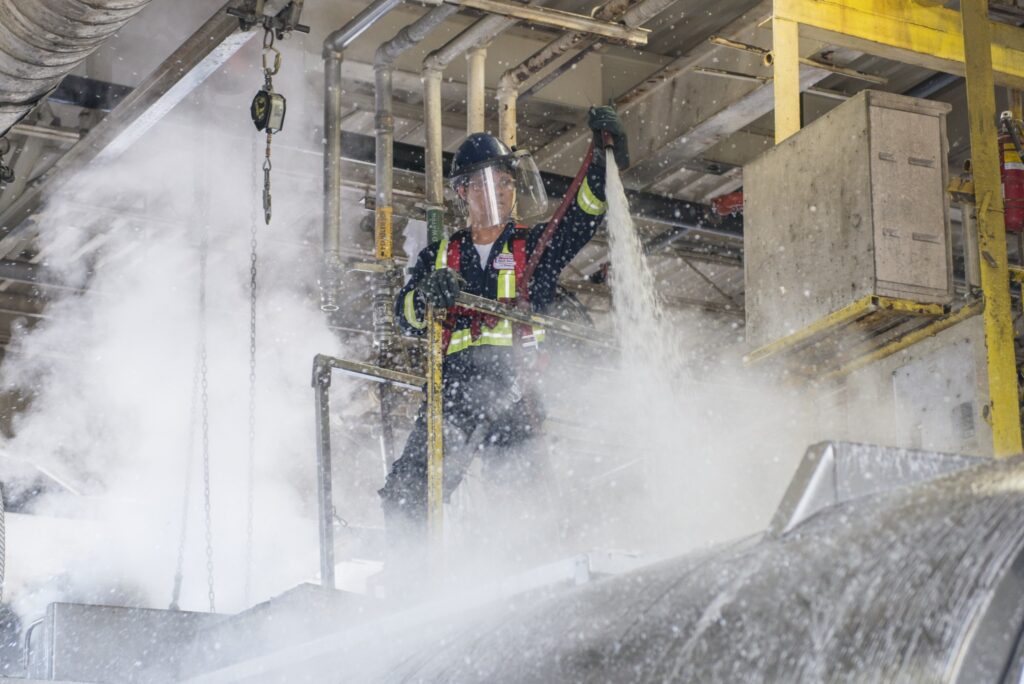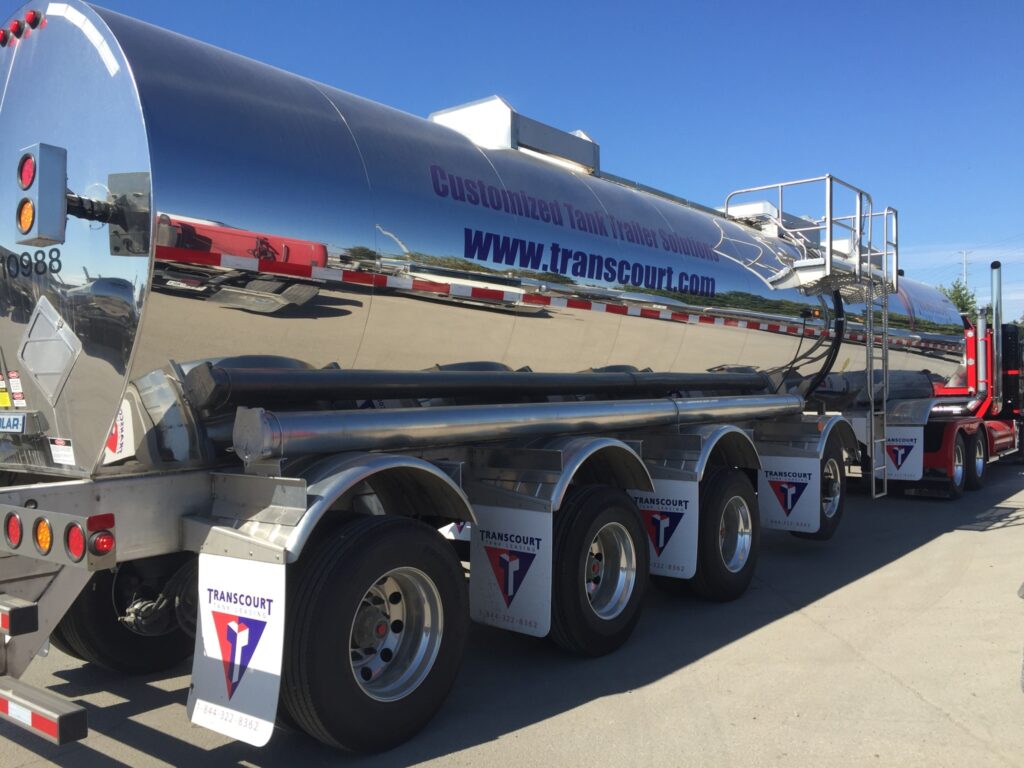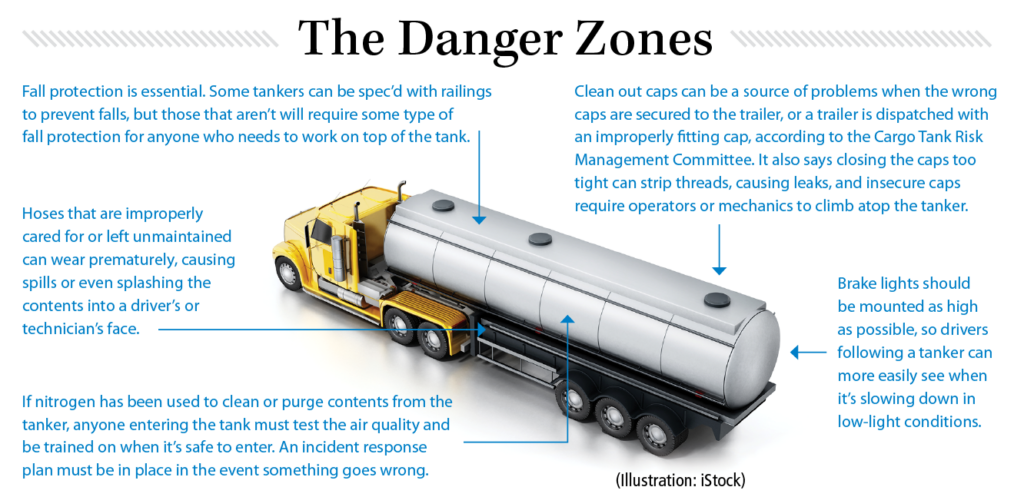Containing risks while working on tanker trailers
Working in, on, and around tanker trailers can be intimidating. Their slick, rounded surfaces make working atop such trailers dangerous, especially at roadside or in the elements. The chemicals such tankers can contain present their own individual risks. And despite the industry’s best efforts, each year headlines tell the story of some poor soul who unknowingly entered a nitrogen-containing tank and was asphyxiated.
However, there are ways to prevent even the most common tanker-related injuries when working on such equipment.
Understand the nitrogen nightmare
Nitrogen can be used in the passivation wash process, and also to purge chemicals from a tank during unloading. The benefit during a wash is that “it almost pickles the stainless steel to make it less permeable to issues like rusting and pitting,” explains Mike Trianos, vice-president – fleet maintenance and procurement with Transcourt Tank Leasing.
When professionally cleaned, the nitrogen is fully removed after the wash. However, it can also be used when unloading certain chemical products.
“Often during the unloading process, chemicals are pressurized with nitrogen to push product off,” warns Corey Kirk, chief engineer with tank maker Tremcar. “If you have a tank full of nitrogen and someone gets inside, it’s an anaerobic environment – there’s no oxygen.”
Nitrogen has no smell and can’t be detected without tools such as various “sniffers,” which detect the presence of a variety of chemicals — including nitrogen – as well as oxygen.
“If someone goes inside [a nitrogen-containing tank], within a minute they will collapse and most likely die,” Kirk warns. “Nitrogen is a significant thing for anyone doing repairs or maintenance work on chemical tanks. They have to make sure the environment is safe before going in.”
The Cargo Tank Risk Management Committee (CTRMC), a U.S.-based group formed to improve safety around tanks and tank trailers, says oxygen levels must be above 19.5% to avoid asphyxiation and possible death.
“Not all trailers or tanks containing nitrogen will be marked with tags or signs,” the group warns in a bulletin. “You should expect a nitrogen atmosphere unless you can prove it is not there.”

Protect against the heightened risk
Working atop tanker trailers comes with the inherent risk of slips and falls, but these can largely be mitigated through spec’ing safety devices and equipping shops with fall protection equipment.
“Anytime someone goes on top of a tank in our shop, they have to be connected with a harness,” Kirk says. “That’s standard practice for us as a manufacturer, but it’s not standard on the maintenance side.”
Tanker spec’s that can help protect technicians include collapsible handrails along the top of the tank, and cable systems that can keep a technician from falling to the ground.
“We put fall protection on all of our trailers. For any trailers that don’t have fall protection, like petroleum trailers, we put a lanyard system so the driver or technician can hook themselves in, preventing falls,” adds Trianos. “The most important thing we do is we put a ground level pressure line on our trailers, so the operator doesn’t have to go up to hook up the pressure hose. Any components you can put on the trailer that keeps the operator on the ground and doesn’t require them to go up on the trailer prevents those types of accidents.”
The CTRMC is campaigning to eliminate cleanout caps on the tops of tankers. Its members claim they’re the most poorly engineered part of a tanker, that overtightening can strip threads and lead to spills, that putting the wrong cap on the wrong trailer can also cause spills, and that they’re no longer necessary to adequately clean out the tank.
“Historically, the end cleanouts of a chemical tank trailer have been used to facilitate the dropping of spinners into the tank to assure the entire inner surface of the vessel is cleaned between loads,” the organization wrote in a white paper on the subject. “Of course, a clean tank is of paramount importance to prevent contamination, corrosion and other perils. But what was deemed necessary 40 years ago may not apply today.”
It cites improvements in spinner technology, the chemistry of cleaning agents, and the wash rack process as opportunities to eliminate cleanout caps, and pointed to a large U.S. bulk carrier that has completely eliminated them from its chemical tank spec’.
However, Trianos cautions the cleanout caps still serve a purpose and give better access to the inside of the tank for washing, especially in Canada where larger tanker trailers are the norm.

Don’t be a hoser
One thing operators often overlook in the field, is care for hoses that are stored along the side of the tank, Trianos observes. Chemical hoses that fall under CSA B620 regulations must be inspected annually, but on the food grade side of things, hoses can be neglected, he adds.
“Because they’re not hauling coded material, a lot of times hoses are not cared for like they should be. Sometimes they burst, causing spills, and can cause splashing in the driver’s face or on their hands,” he says. “Hoses are, I’d say, one of the top causes of injury.”
Explore a bright idea
Many repairs that are completely outside of a tanker fleet’s control come in the form of rear-end damage from collisions. While it may seem unthinkable that someone can run right into the back of a gleaming, stainless steel tanker – it still happens with regularity.
“What we’ve tried to do wit our own fleet is mount the brake lights on the back of the tanker at the 3 and 9 o’clock positions so drivers can see them better from further back, and see when that trailer is braking,” says Transcourt’s Trianos.
The Tandet Group of Companies has taken it a step further. Inspired by the success of U.S.-based Groendyke Transport, which saw rear-end collisions decline by a third after receiving an FMCSA exemption to test the system, Tandet worked with Grote to retrofit a trailer with a pulsating amber light that flashes four times before turning solid red during braking. The traditional brake lamps operate normally.
“We were the first to deploy this technology in Canada,” says Tandet president Scott Tilley. “Tremcar has added it to all new tanks delivered this year and we are retrofitting our fleet on service intervals over the next two years.”
Transport Canada clarified its position on brake-activated pulsating lamps earlier this year, noting it would permit them as long as they don’t interfere with the effectiveness of existing lighting standards. But provinces still have final say, and anyone looking to adopt the safety system should check with provincial regulations. A pulsating red light, for example, is reserved for emergency vehicles and would be a violation.
Trianos is watching with interest to see if the technology becomes mainstream. “It looks intriguing,” he says. “At the same time, we look at the maintenance on something like that, and whether the supply chain will have replacement lights, how much a replacement will cost, and those sorts of things. It’s a great idea and something we are definitely looking into.”

Have your say
This is a moderated forum. Comments will no longer be published unless they are accompanied by a first and last name and a verifiable email address. (Today's Trucking will not publish or share the email address.) Profane language and content deemed to be libelous, racist, or threatening in nature will not be published under any circumstances.